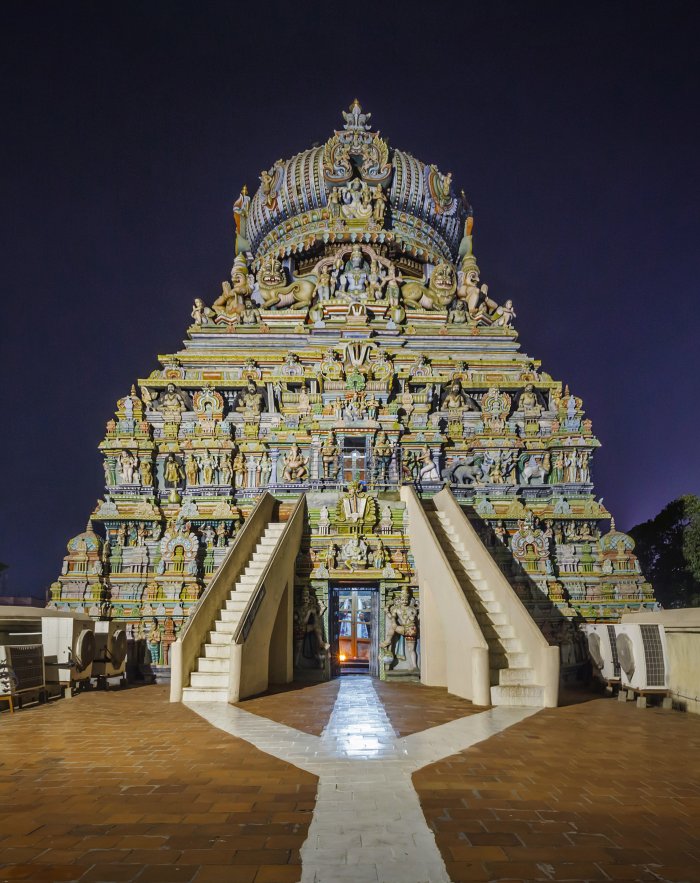Vishnu: Supreme, Universal Hindu God Whose Avatars Reach Nations, Cultures And Races
A. Sutherland - AncientPages.com -In Hindu beliefs, the three gods Brahma, Shiva, and Vishnu, are worshiped as the Great Trinity (Trimurti). They are all generally equal in their power and influence. They represent three aspects: creation, preservation, and destruction.
Vishnu seated on Ananta, facing West (direction of the waters). Second porch. Shrine excavated. Cave 3, Badami, Karnataka. End of the 6th century. Image credit: Ismoon - CC BY-SA 4.0
Observing the Hindu Trimurti, we see Brahma, the creator, looking to the left; Vishnu, the preserver, looks straight ahead, while Shiva, the destroyer, looks to the right.
Vishnu Chief God In Hinduism
The Hindu trinity symbolizes perfection, where Brahma is associated with strength and power; Shiva wins the war thanks to his brutality and impetuous, ruthless character, and Vishnu is a loving God with a special place in the hearts of his believers.
The Hindu god Vishnu is the pervader ("one who is everything and inside everything"), protector, and preserver as he is connected to sacred nature. The mountains are his bones, the clouds hair on his head, the air his breath, the rivers his blood vessels, and the trees are the hairs of his body. We must not forget his eyes represent the sun and the moon, respectively, where the movements of the eyelids symbolize the transition between day and night.
Vishnu is usually depicted with light blue skin and four arms. He is the beautiful guardian of life, light, fire, and water. In four hands, he holds his attributes: a lotus (the symbol of purity and creativity), a club, which symbolizes time. A wheel is a symbol of the cycle of existence, and a conch (shankha), represents a source of all things.
 Kalki Avatar (Image courtesy of Late Sri G. K. Haldipurkar and Aniruddha Haldipurkar, Karwar.) Image credit: Raja Ravi Varma - Public Domain
Kalki Avatar (Image courtesy of Late Sri G. K. Haldipurkar and Aniruddha Haldipurkar, Karwar.) Image credit: Raja Ravi Varma - Public Domain
Vishnu usually wears a pitambara, a unique garment of gold that symbolizes the Vedas; it is said that the divine light of Vishnu shines through his beautiful garment in the same way as the light of truth radiates through the holy words.
He rides on the eagle Garuda, a heavenly bird with four arms and multi-colored wings, and usually rests, floating on Ananta, on the snake Ananta ("Endless" or "infinity") on the primeval waters. Lord Vishnu is often accompanied by his consort, Lakshmi, the Hindu goddess of fortune and the manifestation of Vishnu's energy.
On the forehead, Vishnu has a mark that looks like a U. There are millions of people who worship Vishnu. Those who do so often have the same brand on their foreheads. The mark is drawn there with ash or color.
As the supreme god, he appears in one of his incarnations when his presence is needed.
Ten Incarnations Of Vishnu
Traditionally, Vishnu appears in ten different divine figures (avatars). He takes many various forms to restore cosmic order and eradicate evil. Nine avatars have already come, and the tenth will announce the world's end.
Koodal Azhagar Temple in Tamil Nadu dedicated to Lord Vishnu. Credit: Adobe Stock - Konstantin
His first avatar was the great horned fish Matsya who saved Manu, the first human, from the Great Flood. In his second avatar, he is Kurma (a tortoise) who helps the gods and demons to support the churning of the ocean and recover Amrita, the potion of immortality.
Then, in the third one, Vishnu acts like a wild boar Varaha to kill the demon Hiranyaksha ("Golden Eye"). As legend has it, Varaha is extremely dangerous with a cry louder than god Indra's thunder, and its eyes are brighter than lightning. Shining like the sun, Varaha swims deep down to the seabed to kill Hiranyaksha, and thus he rescues the Earth that once more can float on the surface.
As Narasimha (half-lion half-man) in the fourth incarnation, Vishnu has to destroy Hiranyakasipa, another demon and brother of Hiranyaksha, who also put the planet in danger. Hiranyakasipa knew he was immortal, and no god, animal, or human could kill him. In the fifth reincarnation, Vishnu is Vamana, the dwarf that must act quickly.
His enemy is king Bali, who has already overpowered the three worlds and banished the gods from heaven. Bali offers Vamana as much land as he could cross in three paces. Vamana changes his size and becomes the giant, Trivikrama, so gigantic that he takes Bali's entire kingdom and pushes it down into the underworld.
Vishnu also came as Parashurama (Ram with an ax), then Rama, the hero of the Hindu epic, the Ramayana, and as Krishna, known from the epic, the Mahabharata and other texts. At the same time, the second last Vishnu avatar is Buddha. His tenth incarnation is yet to come, and Vishnu will appear at the end of time in human form, riding on a white horse (in South India, Kalki is depicted as a horse). According to some, the world will be destroyed before a new creation. Others say this idea is based on the Maitreya Buddha doctrine.
In the Mahabharata, Kalki restores the moral order of people on Earth; he judges men and women, punishes evil, and rewards the good.
However, they will still appear on Earth in successive periods, as they are associated with different stages of human evolution on our planet.
Updated on August 4, 2022
Written by – A. Sutherland - AncientPages.com Senior Staff Writer
Copyright © AncientPages.com All rights reserved. This material may not be published, broadcast, rewritten or redistributed in whole or part without the express written permission of AncientPages.com
Expand for referencesReferences:
Jansen E.R. Book of Hindu Imagery
Swami Harshananda, Hindu Gods and Goddesses
More From Ancient Pages
-
 Neanderthals’ Lack Of Drawing Ability Could Explain Why Modern Humans Became Smarter
Archaeology | Feb 11, 2018
Neanderthals’ Lack Of Drawing Ability Could Explain Why Modern Humans Became Smarter
Archaeology | Feb 11, 2018 -
 Caribbean Silk Cotton Tree And Its Dangerous Spirits In Myths And Legends
Featured Stories | Jan 29, 2024
Caribbean Silk Cotton Tree And Its Dangerous Spirits In Myths And Legends
Featured Stories | Jan 29, 2024 -
 Anqa: “Forgotten Twin” Of Dura-Europos Where Time Stood Still
Archaeology | May 9, 2024
Anqa: “Forgotten Twin” Of Dura-Europos Where Time Stood Still
Archaeology | May 9, 2024 -
 Untouched 1,300-Year-Old Grave Of Merovingian Warrior With Complete Armor Found In Ingelheim, Germany
Archaeology | Sep 19, 2023
Untouched 1,300-Year-Old Grave Of Merovingian Warrior With Complete Armor Found In Ingelheim, Germany
Archaeology | Sep 19, 2023 -
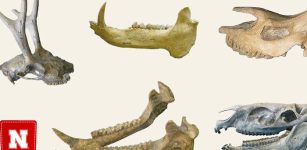 Tooth Analysis Reveal Nebraska Resembled A Dry Savanna 18 Million Years Ago
Archaeology | Jun 8, 2022
Tooth Analysis Reveal Nebraska Resembled A Dry Savanna 18 Million Years Ago
Archaeology | Jun 8, 2022 -
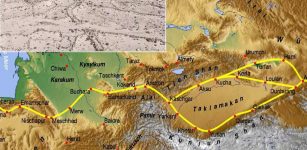 Satellite Images Revealed Lost Ancient Irrigation System In Desert-Like Region Of China
Ancient Technology | Jan 6, 2018
Satellite Images Revealed Lost Ancient Irrigation System In Desert-Like Region Of China
Ancient Technology | Jan 6, 2018 -
 4000-Year-Old Egyptian Leather Manuscript Forgotten For More Than 70 Years – Found
News | Sep 14, 2015
4000-Year-Old Egyptian Leather Manuscript Forgotten For More Than 70 Years – Found
News | Sep 14, 2015 -
 Bees Originated From An Ancient Supercontinent Millions Of Years Earlier Than Previously Thought
Evolution | Jul 31, 2023
Bees Originated From An Ancient Supercontinent Millions Of Years Earlier Than Previously Thought
Evolution | Jul 31, 2023 -
 Ostrich Eggshell Beads Were Social Currency For People Who Lived 33,000 Years Ago
Archaeology | Mar 12, 2020
Ostrich Eggshell Beads Were Social Currency For People Who Lived 33,000 Years Ago
Archaeology | Mar 12, 2020 -
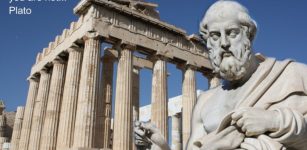 Famous Philosopher Plato: One The Greatest Thinkers Of All Time And His Concept Of Soul
Featured Stories | Jun 25, 2018
Famous Philosopher Plato: One The Greatest Thinkers Of All Time And His Concept Of Soul
Featured Stories | Jun 25, 2018 -
 Early Humans May Have First Walked Upright In The Trees 7 Million Years Ago
Human Beginnings | Dec 17, 2022
Early Humans May Have First Walked Upright In The Trees 7 Million Years Ago
Human Beginnings | Dec 17, 2022 -
 Neanderthals Were Morning People – A New Study Says
Biology | Dec 14, 2023
Neanderthals Were Morning People – A New Study Says
Biology | Dec 14, 2023 -
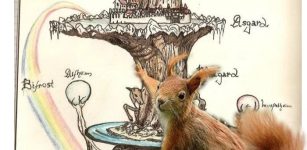 Ratatoskr- Inhabitant Of Yggdrasil That Loves Intrigue, Strife And Gossips In Norse Beliefs
Featured Stories | May 28, 2020
Ratatoskr- Inhabitant Of Yggdrasil That Loves Intrigue, Strife And Gossips In Norse Beliefs
Featured Stories | May 28, 2020 -
 Why Did Archaeologists Destroy Medieval King’s Wharf After Excavations?
Archaeology | May 17, 2023
Why Did Archaeologists Destroy Medieval King’s Wharf After Excavations?
Archaeology | May 17, 2023 -
 Evidence Of Early Human Habitats Linked To Past Climate Shifts Discovered By Scientists
Archaeology | Apr 13, 2022
Evidence Of Early Human Habitats Linked To Past Climate Shifts Discovered By Scientists
Archaeology | Apr 13, 2022 -
 Fascinating Medieval Knight Armor History
Featured Stories | Oct 23, 2018
Fascinating Medieval Knight Armor History
Featured Stories | Oct 23, 2018 -
 On this day in history: Li Shimin becomes Emperor Taizong of Tang, China – Sep 4, 626
News | Sep 4, 2015
On this day in history: Li Shimin becomes Emperor Taizong of Tang, China – Sep 4, 626
News | Sep 4, 2015 -
 6,000-Year-Old Bizarre, Mouthless ‘Alien’ Mask Unearthed In “The Salt Pit” Settlement In Northeast Bulgaria
Archaeology | Nov 20, 2020
6,000-Year-Old Bizarre, Mouthless ‘Alien’ Mask Unearthed In “The Salt Pit” Settlement In Northeast Bulgaria
Archaeology | Nov 20, 2020 -
 Early Humans In The Hula Valley Invested In Systematic Procurement Of Raw Materials Hundreds Of Thousands Of Years Ago
Archaeology | Jul 19, 2023
Early Humans In The Hula Valley Invested In Systematic Procurement Of Raw Materials Hundreds Of Thousands Of Years Ago
Archaeology | Jul 19, 2023 -
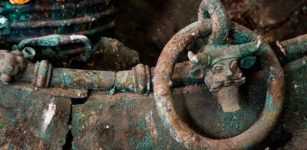 Mystery Of The Lavau Celtic Prince And The Beautiful Ancient Artifacts Hidden In His 2,500-Year-Old Tomb
Archaeology | Jun 5, 2017
Mystery Of The Lavau Celtic Prince And The Beautiful Ancient Artifacts Hidden In His 2,500-Year-Old Tomb
Archaeology | Jun 5, 2017


